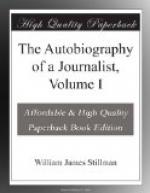Here I first saw Ruskin and was introduced to him. I was looking at some little early drawings of Turner, when a gentleman entered the gallery, and, after a conversation between them, Griffiths came to me and asked if I should not like to be presented to the author of “Modern Painters,” to which I naturally replied in the affirmative. I could hardly believe my eyes, expecting to find in him something of the fire, enthusiasm, and dogmatism of his book, and seeing only a gentleman of the most gentle type, blonde, refined, and with as little self-assertion or dogmatic tone as was possible consistently with the holding of his own opinions; suggesting views rather than asserting them, and as if he had not himself come to a conclusion on the subject of conversation. A delightful and to me instructive conversation ended in an invitation to visit his father’s collection of drawings and pictures at Denmark Hill, and later to spend the evening at his own house in Grosvenor Street. After the lapse of forty-eight years, it is difficult to distinguish between the incidents which took place in this first visit to England in 1850 and those belonging to another a little later, but my impression is very strong that it was during the former that I spent the evening at the Grosvenor Street residence, at which I met several artists of Ruskin’s intimacy, and amongst them G.F. Watts. I then saw Mrs. Ruskin, and I have a very vivid impression of her personal beauty. I remember saying to a friend, to whom I spoke of the visit just after, that she was the most beautiful woman I had seen in England. As I approached the house there was a bagpiper playing near it, and the pipes entered into the conversation in the drawing-room. On my making some very disparaging opinion of their music, which I heard for the first time, Mrs. Ruskin flamed up with indignation, but, after an annihilating look, she said mildly, “I suppose no Southerner can understand the pipes,” and we discussed them calmly, she telling some stories to illustrate their power and the special range of their effect.
At that time Ruskin held very strong Calvinistic notions, and as I kept my Puritanism unshaken we had as many conversations on religion as on art, the two being then to me almost identical and to him closely related. I remember his saying once, in speaking of the doctrine of foreordination (to me a dreadful bugbear), as I was drinking a glass of sherry, that he “believed that it had been ordained from all eternity whether I should set that glass down empty or without finishing the wine.” This was to me the most perplexing problem of all that Ruskin put before me, for it was the first time that the doctrine of Calvin had come before me in a concrete form. Another incident gave me a serious perplexity as to the accuracy of Ruskin’s perceptions of nature. Leslie had given me a card to see Mr. Holford’s collection of pictures, in which was one of Turner’s, the balcony scene in Venice, called, I think, “Juliet




